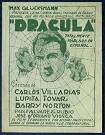|
|
||||
|
|
by Adam Hakari  The Spanish version of 1931's Dracula is one of the most famous alternate cuts in film history. Remakes and revamps abound these days, but it wasn't uncommon for studios to make entirely new variants of their own stuff for other markets back then. Though the Bela Lugosi take still overshadows it in the mainstream, Dracula en Español has received its due, accompanying its English companion on virtually all its DVD incarnations. The jury's still out on which emerges as the better bloodsucker, but both are creepy classics worth popping in on a dark and stormy night. Lugosi enthusiasts will be relieved that the story remains as is, although some names have been changed to protect the undead. Real estate agent Renfield (Pablo Alvarez Rubio) is heading out deep into the Carpathian Mountains to rendezvous with his latest client, Count Dracula (Carlos Villarias). He arrives to find a foreboding abode and even more ominous Count, who reveals his vampiric nature and soon commands Renfield under his thrall. Upon relocating to high society, Dracula sets about spreading his evil throughout the modern world, starting with the alluring Eva Seward (Lupita Tovar). But if the valiant Professor Van Helsing (Eduardo Arozamena) has any say in the matter, the Count has quite the fight ahead of him if he truly craves Eva's soul. The qualities of each Dracula are one matter, but the Spanish version does have its advantages. Since director George Melford and crew shot at night, they saw what Tod Browning had filmed during the day and seized the chance to do one better. A similar script and even the same sets were used, although Melford's Dracula is a noticeably different experience. For one, the length runs half an hour longer; as the sun set on Lugosi, the battle against Villarias was just beginning. The extra time is the work of numerous patches of silence, some which allow the spookiness to sink in and some which are frustratingly inert. But the film's themes are given a boost, as it appears to concentrate more on the religious side of the supernatural. Giving deranged Renfield lucid theological monologues is a stretch, but Melford reminds you the vampire was born in myth and folklore, not in weekend matinees. Where this Dracula distinguishes itself most, however, involves the interpretations key players bring to their characters. Most roles remain unchanged: Barry Norton's "Juan" Harker is a drip, Van Helsing is suitably defiant, and Tovar's Eva/Mina is the picture of innocence (though her wardrobe is much less conservative than Helen Chandler's). While Lugosi played Dracula as an elegant predator, Villarias offers viewers a wolf in wolf's clothing. With a constant crazed look in his eye and an eerie grin to rival the Joker's, he always seems one beat away from tearing into someone like a quarter-pounder. He's not subtle by any definition, but it's interesting to see the man show us a Dracula whose hunger is tearing away at what little of a soul he has left. We also see Rubio do more cackling in one film than in Gene Wilder's entire career; Dwight Frye was a creepy fella, but Rubio's Renfield appears completely off his rocker. Choosing between these classic Draculas is a task even Van Helsing would shy away from. Both have their strengths (wonderful atmosphere) and weaknesses (too many slow stretches), so declaring a champion is darn near impossible. Lugosi himself remains king of the Counts, but Melford's creepy direction and an unforgettable turn by Villarias make this Dracula worthy of a wing in Universal's house of horrors. MY RATING: *** (out of ****) (Adam's review of the English language Dracula can be read at Classic Movie Guide: www.classicmovieguide.com.) |
||
|
© 2026 - ReelTalk Movie Reviews Website designed by Dot Pitch Studios, LLC |



